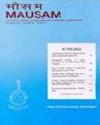Linking the solar cycle and Earth’s climate
IF 0.7
4区 地球科学
Q4 METEOROLOGY & ATMOSPHERIC SCIENCES
引用次数: 1
Abstract
In this paper, the authors have made an effort to investigate the impact of the solar cycle on Earth’s climate in the context of rainfall and temperature over a location, on El Nino/ La Nina, and world famines. The study shows that the peak sunspot number (SSN) often occurs in pairs. Multiple peaks are also seen frequently. The La Ninas follow multiple peaks, or sometimes associated with it. The El Ninos usually follow the solar minima, though not always. This study shows that the SSN trough will occur in 2020, thereby causing El Nino during 2019-2021. The multiple SSN peak is likely to occur during 2023-2028, predicting a La-Nina during this period. Multiple SSN peaks and very high SSN values bring about famines. The study shows that the total solar irradiance (TSI) bears a strong correlation with the SSN. Besides, the cosmic ray flux decreases as the SSN and the TSI increases. The monthly and yearly variations of SSN, TSI, and temperature show increasing trends over the years, indicating increased warming as the years advance. However, none of these parameters bears significant correlations with the temperature, either independently or together, implying that some other factors are also responsible for determining the temperature. The study shows no direct relationship between rainfall and the SSN. However, several years show a similar trend between the two. The investigation indicates a strong influence of the solar cycle on world climate.将太阳周期和地球气候联系起来
在这篇论文中,作者们努力研究太阳周期对一个地区的降雨量和温度、厄尔尼诺/拉尼娜现象和世界饥荒对地球气候的影响。研究表明,太阳黑子数峰值(SSN)经常成对出现。多个峰值也经常出现。拉尼娜现象遵循多个峰值,有时与之相关。厄尔尼诺现象通常遵循太阳极小值,但并不总是如此。这项研究表明,SSN槽将发生在2020年,从而导致2019-2021年的厄尔尼诺现象。多重SSN峰值可能发生在2023-2028年,预测这一时期将出现拉尼娜现象。多个SSN峰值和非常高的SSN值导致饥荒。研究表明,太阳总辐照度(TSI)与SSN具有很强的相关性。此外,宇宙线通量随着SSN和TSI的增加而减小。SSN、TSI和温度的月变化和年变化显示出多年来的增加趋势,表明随着时间的推移,变暖加剧。然而,无论是独立的还是共同的,这些参数都与温度没有显著的相关性,这意味着其他一些因素也有助于确定温度。研究表明,降雨量和SSN之间没有直接关系。然而,几年来,两者之间出现了类似的趋势。调查表明,太阳周期对世界气候有很大影响。
本文章由计算机程序翻译,如有差异,请以英文原文为准。
求助全文
约1分钟内获得全文
求助全文
来源期刊

MAUSAM
地学-气象与大气科学
CiteScore
1.20
自引率
0.00%
发文量
1298
审稿时长
6-12 weeks
期刊介绍:
MAUSAM (Formerly Indian Journal of Meteorology, Hydrology & Geophysics), established in January 1950, is the quarterly research
journal brought out by the India Meteorological Department (IMD). MAUSAM is a medium for publication of original scientific
research work. MAUSAM is a premier scientific research journal published in this part of the world in the fields of Meteorology,
Hydrology & Geophysics. The four issues appear in January, April, July & October.
 求助内容:
求助内容: 应助结果提醒方式:
应助结果提醒方式:


